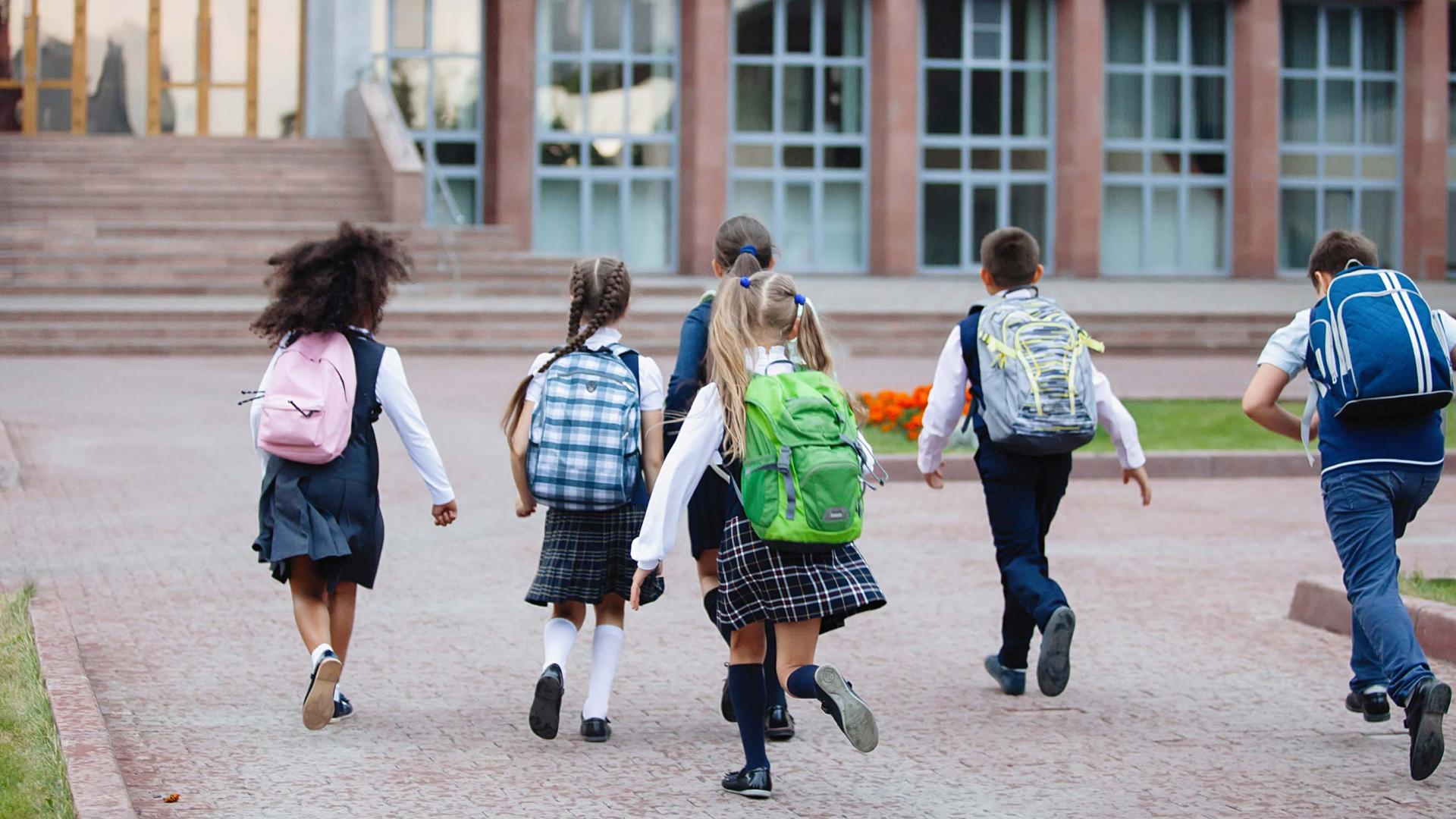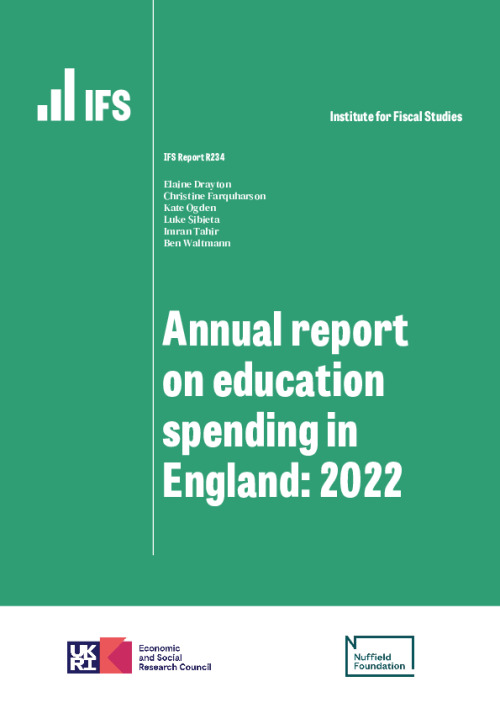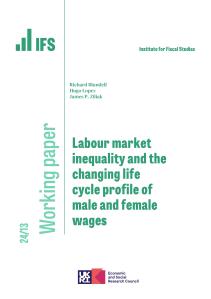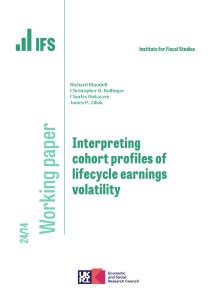Executive summary
This is our fifth annual report on education spending funded by the Nuffield Foundation. It seeks to provide a clear and consistent comparison of the level and changes in spending per student across different stages of education.
Following on from cuts to most areas of education spending during the 2010s, the government has provided additional funding at successive spending reviews between 2019 and 2021. However, rising levels of inflation and cost pressures have dampened the effects of extra funding, putting severe strain on providers’ budgets right across the public sector. High ambitions for the education sector will also be harder to achieve in an era of further constraints on public spending.
Total spending
1. In 2021–22, total spending on education in the UK stood at £116 billion or 4.6% of national income (including the cost of issuing student loans). This is about the same share of national income as in the early 2000s, mid 1980s and late 1960s, but lower than the mid 1970s and late 2000s, when it was well over 5% of national income.
2. Between 2010–11 and 2019–20, there was a real-terms cut of 8% or £10 billion in total education spending. A £7 billion increase over the next two years reversed much of this cut, such that education spending was only 2% lower by 2021–22 than in 2010–11. About two-thirds of the rise since 2019–20 (or £4.5 billion) reflects standard increases in education spending, whilst about £2.5 billion reflects a higher and more volatile cost of issuing student loans.
3. In the late 1970s, education spending represented 12% of total government spending, making it the equal largest area of government spending. This has since fallen to 10% of total government spending in 2021–22, which equals a historical low point. At the same time, we estimate that 20% of the UK population was in full-time education in 2021–22, equal to the highest it has been in at least 60 years. In sharp contrast, as the share of the population over 65 has risen, the share of total spending on healthcare has more than doubled from just over 9% in the late 1970s to over 20% today.
Early years
1. Spending on the early years continued to grow after 2010, even as other areas of education spending saw cuts. Spending on the free entitlement to a funded childcare place was around £4 billion last year, about double the level in 2010–11.
2. While spending per hour increased by 28% in real terms between 2009–10 and 2021–22, the bulk of the increase in free entitlement spending has been driven by the addition of new entitlements, for disadvantaged 2-year-olds and for 3- and 4-year-olds in working families.
3. Childcare providers are currently experiencing faster rises in costs than overall levels of inflation. With many workers earning at or near the minimum wage – and a high share of costs going towards staffing – recent rises in the National Living Wage have pushed up costs. We estimate that the prices facing childcare providers will have grown by 32% between 2017–18 and 2024–25. This is above the 21% growth in the GDP deflator – the standard measure of inflation for assessing real-terms changes in public spending.
4. Higher-than-expected inflation has eroded the value of planned increases in spending on the free entitlement. Considering rises in costs specific to childcare providers, we estimate that total spending on the free entitlement will buy 9% less in 2024–25 compared with 2021–22. Virtually all of this squeeze is yet to be felt.
5. This overall squeeze will be mitigated somewhat when looking at hourly funding because of an expected drop in the number of 3- and 4-year-olds. The real-terms value of core funding per hour – currently at £5.06 per hour – will drop by 3%.
6. While free entitlement spending has risen, spending on childcare subsidies through the working-age benefit system fell from £1.8 billion in 2009–10 to £660 million in 2021–22. Whilst some of this decline relates to the effects of the pandemic, it mainly reflects less generous payments, a squeeze on caseloads and, more recently, the transition to universal credit.
Schools
1. School spending per pupil in England fell by 9% in real terms between 2009–10 and 2019–20. This represents the largest cut in over 40 years, but it came on the back of a significant increase in spending per pupil of over 60% during the 2000s.
2. As a result of recent increases in school funding, we estimate that school spending per pupil will grow in real terms through to 2024 and will return to at least 2010 levels, even after accounting for the specific costs faced by schools. The additional £2.3 billion in the 2022 Autumn Statement puts schools in a better position to meet the cost of increases in teacher salaries (over 5% this year), support staff salaries (8–9%), and rapid rises in energy and food costs. However, no net growth in school spending per pupil over a 14-year period still represents a significant squeeze on school resources.
3. Secondary school spending per pupil in England in 2022–23 is due to be about £6,900, which is 14% higher than in primary schools (£6,100). This is down from a secondary/primary funding difference of about 30% in the 2000s and over 50% during the early 1990s.
4. The pupil population is expected to decline by 700,000 or 9% between 2024–25 and 2030–31. This would reverse all of the increase in the pupil population since 2010–11 and create less demand for school places. However, declining pupil numbers will only reduce spending needs if schools are able to shrink their costs and staff numbers in equal measure.
Further education and skills
1. Between 2010–11 and 2019–20, spending per student aged 16–18 fell by 14% in real terms in colleges and by 28% in school sixth forms. For colleges, this left spending per student at around the level it was in 2004–05, while spending per student in sixth forms was lower than at any point since at least 2002.
2. In the 2019 and 2021 spending reviews, the government announced extra funding for colleges and sixth forms. As a result, overall per-student spending in 16–18 education is set to rise by 9% in real terms between 2021–22 and 2024–25. Yet even with the additional funding, college spending per pupil in 2024–25 will still be around 5% below 2010–11 levels, while school sixth-form spending per sixth-form pupil will be 22% below 2010–11 levels.
3. Colleges and sixth forms have seen a long-term decline in spending per student relative to schools. Further education spending per student aged 16–18 in 2022–23 was £6,800, which is lower than spending per pupil in secondary schools and only 11–12% greater than in primary schools having been more than two times greater in the early 1990s.
4. Further education colleges and sixth forms are in a particularly difficult position at present. They saw larger cuts than other areas of education after 2010 and there was no extra funding announced in the 2022 Autumn Statement to help colleges and sixth forms cope with larger-than-expected cost increases. Based on existing budgets, college staff have only been offered a pay rise of 2.5% for this year, well below the 5% offered to teachers; this could exacerbate recruitment and retention difficulties in colleges. The number of 16- to 18-year-olds is projected to rise by 18% between 2021 and 2030, which would make for 200,000 extra students by 2030. This comes at a time when the government has scaled back departmental spending plans after 2024.
5. In the 2021 Spending Review, the government chose to allocate an extra £900 million in funding for adult education and apprenticeships in 2024–25 compared with 2019–20. As a result, total spending on adult skills is set to increase by 22% between 2019– 20 and 2024–25. However, as with spending on 16–18 education, this only reverses a fraction of past cuts: total adult skills spending in 2024–25 will still be 22% below 2009–10 levels. Spending on classroom-based adult education has fallen especially sharply, and will still be 40% below 2009–10 levels even with the additional funding.
6. While there has been a sharp decline in public spending on classroom-based adult education, funding for apprenticeships has remained fairly constant at around £2 billion in real terms since the late 2000s. In 2016–17, the level of public spending on apprenticeships overtook public spending on classroom-based adult education. Between 2019–20 and 2021–22, apprenticeship spending rose by 10%; part of this increase is likely due to apprenticeship activity recovering post-pandemic.
7. Following on from big increases between 2010 and 2015, the total number of adult apprentices has declined by 27% since 2016–17 and the introduction of the apprenticeship levy. However, the number of higher apprentices, which include degree apprentices, has more than trebled in the same period.
Higher education
1. Up-front spending on teaching resources per higher education student has continued to decline steadily, standing at £9,300 per year for the 2022–23 university entry cohort. That is around £1,700 less per year in real terms than for 2012–13 entrants, largely because the cap on tuition fees is now 18% lower in real terms than it was in 2012–13.
2. The nominal freeze in fees is set to continue for another two years, adding to other financial pressures on universities. The most important pressure in the near term is likely to be the cost of any settlement with staff over pay and pensions.
3. A major package of student loans reforms was announced in February and has substantially reduced the expected long-run cost of higher education, shifting a larger share of the cost onto graduates themselves. Changes to future repayment thresholds mean most students from the 2012 to 2022 university entry cohorts can expect to repay substantially more, with middle-earning graduates hit hardest.
4. From the 2023 entry cohort onwards, a lower repayment threshold, a longer repayment period and a lower interest rate mean most students can expect to repay their loans in full and to repay roughly the same amount as they borrowed in real terms. High earners will no longer pay off more than they borrowed, and only low-earning graduates’ loans will be subsidised by the taxpayer.
5. For current students, higher-than-expected inflation has eroded the real value of maintenance loans. Students in 2022–23 will be entitled to borrow 10% less towards their living costs than they were in 2020–21, a cut equivalent to £90 a month for the poorest students. Without a change in policy, living cost support for future students will be permanently lower, causing hardship for some.
Our dedicated website (https://ifs.org.uk/education-spending) further provides easy access to our latest analysis, figures and the underlying methodology.















